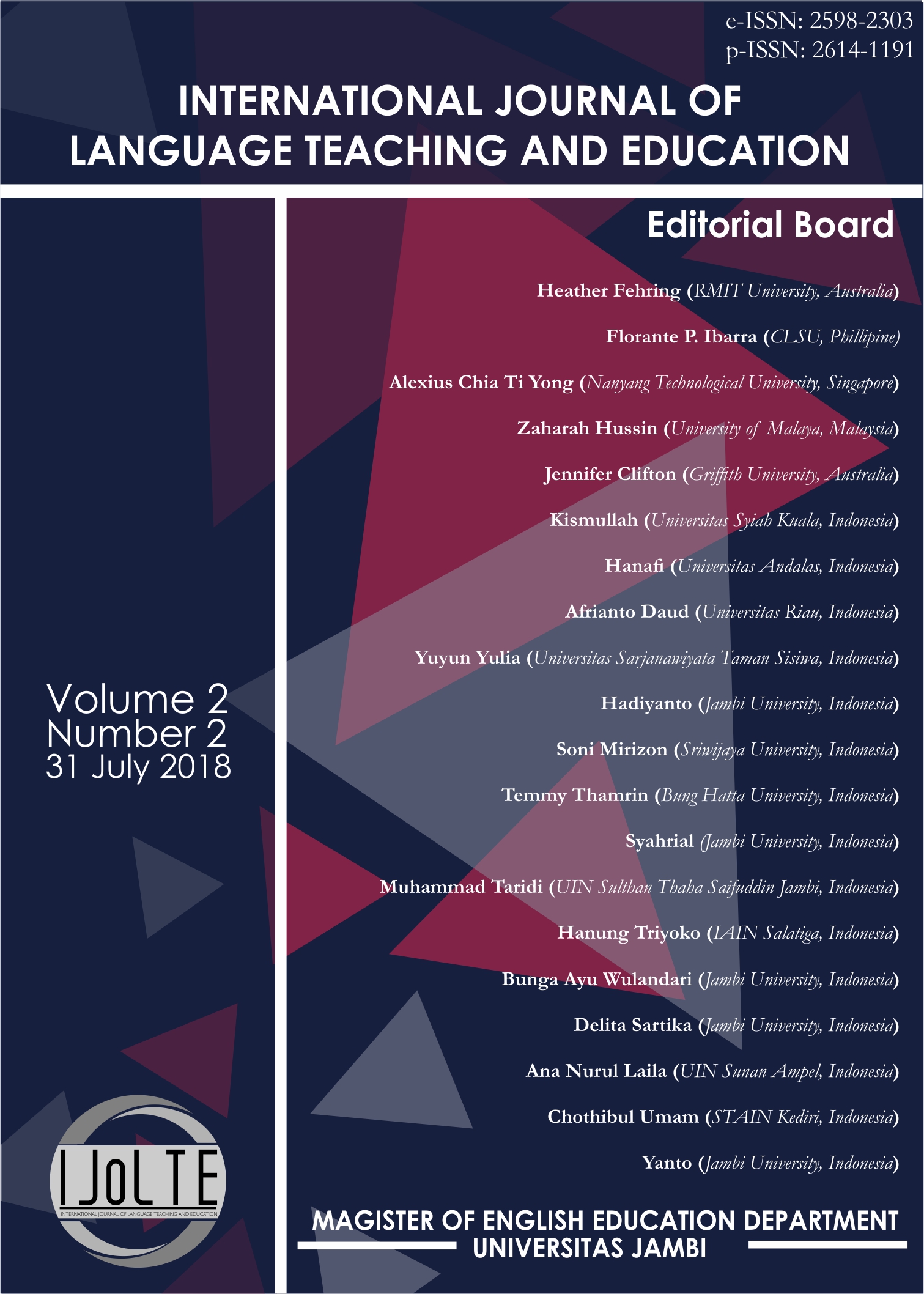How Phase theory can be used to improve reading comprehension in children
DOI:
https://doi.org/10.22437/ijolte.v2i2.5051Keywords:
Phase theory, rote learning, decoding, development in reading, skilled readersAbstract
The present paper gives summary about some development theories which focuses on how development of reading takes place in a child. It then focuses on one particular theory, i.e. the Phase theory by Ehri (1999) where this theory mentions with the help of four stages how a child goes from the stage of no knowledge of letters to full knowledge of letters in children. Though this theory has been criticized by some but it is still considered as the theory which explains the basic stages of development in a child while reading while refuting the earlier theories on development of reading. Further, this paper discusses how this theory can be used as a form of instruction for children to develop reading comprehension.
Downloads
References
[2] Cain, K. (2010). Reading development and difficulties: An introduction. Oxford: Wiley-Blackwell.
[3] Ehri, L.C. (1999). Phases of development in learning to read words. In J. Oakhill & R. Beard (Eds.), Reading development and the teaching of reading: A psychological perspective, (pp. 79–108). Oxford: Blackwell Science.
[4] Ehri, L.C. (1998). Grapheme-phoneme knowledge is essential for learning to read words in English. In J.L. Metsala & E.C. Ehri (Eds.), Word recognition in beginning literacy, (pp. 3–40). Mahwah, NJ: Erlbaum.
[5] Frith, U. (1985). Beneath the surface of developmental dyslexia. In K. Patterson, J. Marshall & M. Coltheart (Eds.), Surface dyslexia: Neuropsychological and cognitive studies of phonological reading, (pp. 301–330). London: Erlbaum.
[6] Gough, P. B., & Hillinger, M. L. (1980). Learning to read: An unnatural act. Bulletin of the Orton Society, 30, 179–196.
[7] Marsh, G., Friedman, M., Welch, V., & Desberg, P. (1981). A cognitive-developmental theory of reading acquisition. In Mackinnon, G. E., Waller, T. G. (Eds.), Reading research: Advances in theory and practice, (Vol. 3, pp. 199–221). New York: Academic Press.
[8] Mason, J. (1980). When do children begin to read: An exploration of four year old children's letter and word reading competencies. Reading Research Quarterly, 15, 203-227.
Downloads
Published
Versions
- 2018-07-31 (1)
- 2018-07-31 (1)
How to Cite
Issue
Section
License
The Authors submitting a manuscript do so on the understanding that if accepted for publication, copyright of the article shall be assigned to International Journal of Language Teaching and Education (IJoLTe) and Magister Program of English Education Department, Universitas Jambi as publisher of the journal. Copyright encompasses rights to reproduce and deliver the article in all form and media, including reprints, photographs, microfilms, and any other similar reproductions, as well as translations.
IJoLTe keep the rights to articles that have been published. And, the authors are permitted to disseminate published article by sharing the link of IJoLTe' website. Authors are allowed to use their works for any purposes deemed necessary without written permission from IJoLTe with an acknowledgement of initial publication in this journal.
IJoLTe and Magister Program of English Education Department, Universitas Jambi, and the Editors make every effort to ensure that no wrong or misleading data, opinions or statements be published in the journal. In any way, the contents of the articles and advertisements published in IJoLTe are the sole and responsibility of their respective authors and advertisers.
If the article was jointly prepared by more than one author, any authors who submitting the manuscript warrants that he/she has been authorized by all co-authors to be agreed on this copyright and license notice (agreement) on their behalf, and agrees to inform his/her co-authors of the terms of this policy. IJoLTe will not be held liable for anything that may arise due to the author(s) internal dispute. IJoLTe will only communicate with the corresponding author.
By submitting the article/manuscript to this journal, the authors agree with this policy and consciously agree that IJoLTe does not provide royalties or other fees to the authors for their published articles. By agreeing this policy, IJoLTe ensures that published articles are publicly accessible and will be free of charge for the readers. No specific document sign-off is required.
Users of this website will be licensed to use materials from this website following the Creative Commons Attribution 4.0 International License. Please use the materials accordingly
You are free to:
- Share — copy and redistribute the material in any medium or format
- Adapt — remix, transform, and build upon the material for any purpose, even commercially.
- The licensor cannot revoke these freedoms as long as you follow the license terms.








1.png)
